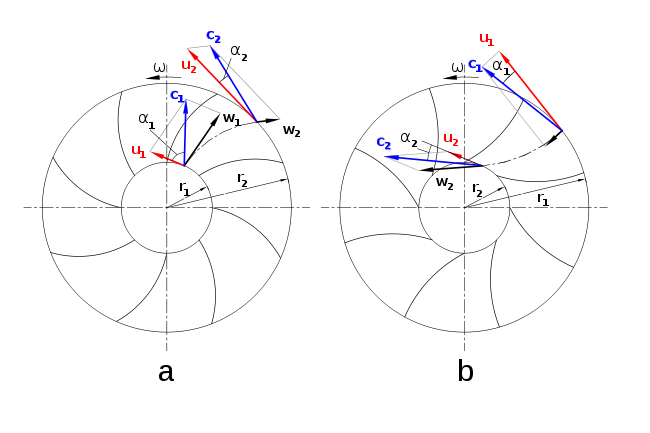Euler's pump and turbine equation
The Euler’s pump and turbine equations are most fundamental equations in the field of turbo-machinery. These equations govern the power, efficiencies and other factors that contribute in the design of Turbo-machines thus making them very important. With the help of these equations the head developed by a pump and the head utilised by a turbine can be easily determined. As the name suggests these equations were formulated by Leonhard Euler in the eighteenth century.[1] These equations can be derived from the moment of momentum equation when applied for a pump or a turbine.
Conservation of angular momentum
Another consequence of Newton's second law of mechanics is the conservation of the angular momentum (or the “moment of momentum”) which is of fundamental significance to all turbomachines. Accordingly, the change of the angular momentum is equal to the sum of the external moments. Angular momentums ρ×Q×r×cu at inlet and outlet, an external torque M and friction moments due to shear stresses Mτ are acting on an impeller or a diffuser.
Since no pressure forces are created on cylindrical surfaces in the circumferential direction, it is possible to write Eq. (1.10) as:
- (1.13)[2]
Triangle velocity

The color triangle formes
by velocity vector u,c,w call 'triangle velocity" this is an important role in old academic, this rule was helpful to detail Eq.(1) become Eq.(2) and wide explained how the pump works.
- and are the absolute velocities at the inlet and outlet respectively.
- and are the relative velocities at the inlet and outlet respectively.
- and are the velocities of the blade at the inlet and outlet respectively.
- is angular velocity.
Fig 1 shows triangle velocity of backward curved vanes impeller ; it's illustrate rather clearly energy add to the flow (shown in vector c) inversely change upon flow rate Q (shown in vector cm).
Euler's pump equation
Based on Eq.(1.13), Euler developed the equation for the pressure head created by the impeller (see Fig.1).
- (1)
- (2)
Yth : theoretical specific supply ; Ht : theoretical head pressure ; g : gravitational acceleration
For the case of a pelton turbine the static component of the head is zero, hence the equation reduces to (See Fig.2).
Usage
Euler’s pump and turbine equations can be used to predict the impact of changing the impeller geometry on the head. Qualitative estimations can be made from the impeller geometry about the performance of the turbine/pump. For the design of an aero-engines and the designing of power plants, the equations assume prime significance. Thus for the design aspect of turbines and pumps, the Euler equations are extremely useful.
See also
References
- ↑ See:
- Euler (1752) "Maximes pour arranger le plus avantageusement les machines destinées à élever de l'eau par moyen des pompes" (Maxims for arranging most advantageously machines intended to raise water by means of pumps), Mémoires de l'Académie Royale des Sciences et des Belles Lettres à Berlin, 8 : 185-232. Here, Euler presents his results for maximizing the outputs of windmills and water wheels, among other means of powering pumps.
- Euler (1754) "Théorie plus complette des machines qui sont mises en mouvement par la réaction de l'eau" (More complete theory of machines that are set in motion by reaction with water), Mémoires de l'Académie Royale des Sciences et des Belles Lettres à Berlin, 10 : 227-295. An analysis of Segner's wheel.
- Euler (1756) "Recherches plus exactes sur l'effect des moulins à vent" (More exact research on the effect [i.e., work output] of windmills), Mémoires de l'Académie Royale des Sciences et des Belles Lettres à Berlin, 12 : 166-234.
- ↑ Johann Friedrich Gülich (2010). Centrifugal Pumps (2nd ed.). Berlin: Springer-Verlag. ISBN 978-3-642-12823-3.